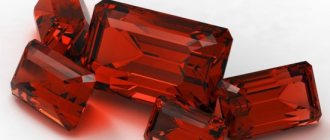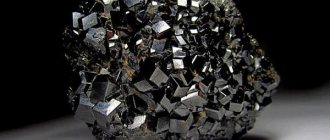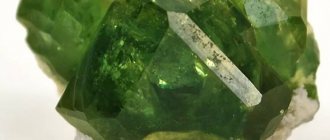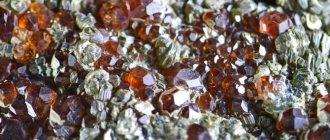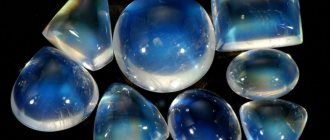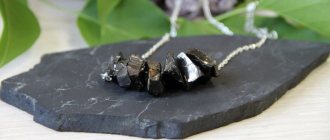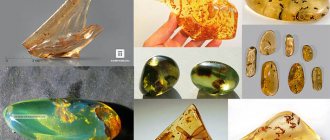Garnet is a semi-precious stone that has strong energetic power and dazzling beauty. It got its name due to its similarity to pomegranate seeds. Most people are accustomed to thinking that a gem can only be colored in bright red shades, but this is far from the case. Nature has not been greedy for the mineral of flowers, so you can find orange, pink, green, yellow, brown, purple and even black varieties of the crystal.
Due to the fact that garnet is a fairly common mineral, and even belongs to the group of semi-precious stones, they have learned to fake it very well and sell it at the price of natural stones.
To know how to distinguish a natural stone from a fake or synthetic one, we suggest you familiarize yourself with our recommendations and the basic properties of the mineral.
What does a gem look like?
To analyze samples, you should know what the standard is, that is, natural garnet.
The gem looks like the fruit of a southern fruit. Dark purple, that is, a shade of garnet, is considered classic. There are other colors, not just blue. They are created by impurities of manganese, calcium, chromium, iron, and magnesium.
Pomegranate substitutes
Most often, glass or plastic is offered instead of mineral. A technology has been developed for producing a special type of garnet glass with a color that imitates natural glass. Due to the low cost of garnet, stones to imitate it are rarely used.
It is more difficult to distinguish garnets from fakes if they are artificially grown stones such as cubic zirconia. Jewelry with several stones (bracelet or beads) requires attention. In them, a real garnet can coexist with fakes.
Product care
To ensure that the stone always looks attractive, you should purchase jewelry with garnet only on a sunny day.
If you received the product from a previous owner, you should clean the stone by placing it in running water for a day.
Once the mineral is in your hands, there are easy rules for caring for the stones so that they do not become dirty.
- If it becomes dirty, wash the jewelry in a mild soap or saline solution.
- A soft brush will help for cleaning. Can be used with a couple of drops of ammonia.
- For shine, wipe the stone with a soft cloth, avoiding hard sponges and abrasives.
- For storage, you should remove the pomegranate away from sharp objects and chemical materials. Store separately from other jewelry, in a separate velvet bag.
We took a closer look at the precious mineral, which is called the exotic fruit, pomegranate. We learned its main properties and features. We learned that a pomegranate, chosen correctly, will become a talisman for many years. It will lead the owner to wealth and happiness when used correctly.
How to recognize a fake
The color scheme of the stone creates scope for those who love counterfeiting. There are simple ways to determine the origin of a stone at home.
Visual analysis
The size, color, and transparency of the sample are assessed. Examine a pebble in the light. A magnifying glass will come in handy.
- Size. A nugget pomegranate has the dimensions of a grain of the fruit of the same name. After processing they are even smaller. If the crystals are larger, it is a fake. Especially green stones. They are rare and prohibitively expensive. Bypassing the counters, they end up in private, corporate or state treasuries.
- Coloring. The garnet is fragmentary. Even elite jewelry samples have gradations and zoning of color and different densities. It is possible for one stone to have shades. Fake specimens are painted evenly.
- Inclusions. Pure specimens are rare, expensive, and inaccessible. Unlike an artificial one, a real gem has small inclusions. But not gas bubbles - they only exist in glass.
- Shine. Even when cut, the natural gem has a muted, matte, velvety shine. Synthetic is dazzling.
- Play of light. Garnet transmits light unevenly, refracting at the edges. Visually it looks like an internal play of light. This is not possible for counterfeiting.
It is unreasonable to shell out a lot of money for a large shiny pebble without “foreign objects” or with bubbles inside.
Mechanical impact
Determination methods are based on the physical properties of the mineral.
- Scratching. The hardness of garnet is high. It easily scratches glass or plastic. If there is no trace left or the sample being tested is damaged as a result of scratching, it is not a garnet, but plastic or a cheap gem.
- Heating. Garnet is, although precious, a stone. Glass or plastic heats up in your hands faster than it does. If the sample remains cool after a few minutes, it is a mineral. It's easy to feel the difference by holding the sample and the glass at the same time.
- Magnetism. Garnet has the property of being magnetized. The experiment is carried out on highly sensitive (electronic or carat) scales. For the purity of the experiment, their steel surface is insulated. That is, cork, plastic or other insulating material is placed on the scales, and the sample being tested is placed on them. The readings are recorded when the pomegranate is at rest. Then they pass a magnet over it (about 1 cm) and look at the numbers. If the weight has decreased, it is a garnet - the pebble seems to be pulled by a magnet.
- Electrification. When rubbed, the stone becomes electrified. If you rub a pomegranate on wool, it will attract pieces of paper, hair, straws, and fluff.
We recommend reading: Amethyst – real or artificial, how to check?
The latter experience will help distinguish a natural mineral from a man-made one, but not from glass. It is also electrified.
Artificial pomegranate
Laboratory-grown stones are larger, purer than natural ones, and evenly colored. Hard, cut well. Treated crystals play in the light. Recognized by the following characteristics:
- arcs, rings or straight segments (crystal growth lines);
- are not magnetized;
- are not electrified.
Jewelry stones have been grown around the world since the late 1960s. The technology is complex, so prices are comparable to its natural counterpart. Since 1973, in the USSR, jewelry was supplied with artificial garnets in pink, pale purple, yellow shades, colorless and cubic zirconia, and two years later - with emeralds. So inherited Soviet-era jewelry does not always contain natural stones.
Artificial garnet stone
Garnet stones artificially grown in chemical laboratories are not considered fakes.
Hydrothermal garnet
Such specimens are cultivated from small particles remaining after processing natural stone. The obtained grains differ from natural grains in their larger size, uniform, without inclusions, color, and high-quality cut. Artificial growth of crystals leads to such characteristic features of growth lines as arcuate and ring-shaped segments, straight lines. Synthetic stones are identified by them. And they are not magnetized or electrified, unlike natural ones.
Growing pomegranate in specialized laboratories of the Soviet Union began in the 50s of the last century. Russian synthetic gem - pink, purple, yellow. Production is still common today. Hydrothermal technology is expensive, so the cost of an artificial analogue is close to natural.
Synthetic garnet is widely used in jewelry, either as pyrope itself or as an imitation of ruby.
The most popular artificial materials, especially used in technology, are yttrium-aluminum (YAG), gallium-gadolinium (GGG), gadolinium-gallium-scandium garnets (GGSG), and lithium niobate.
It is yttrium-aluminum garnets that imitate jewelry stones. Without the addition of impurities, they are colorless and strongly resemble diamond. Adding chromium gives green, manganese gives red, and titanium gives yellow. Green YAG is difficult to distinguish from natural demantoid. However, it is not difficult to check the authenticity of synthetic grenades, including YAG.
Monocrystalline gadolinium gallium synthetic garnet is transparent, has a brownish tint, and is highly shiny. But it is not hard enough to gain fame as a jewelry material. GGG has special physical characteristics, due to which it is used in quantum paramagnetic amplifiers and high-power lasers, in magnetooptics, microelectronic technology and other areas.
Sitall garnet - what is it?
Sitall is a material obtained by volumetric crystallization of glass under hydrothermal conditions. In other words, super-strong glass. Here is the answer to the question: is sital garnet a natural stone? Used in construction, industry and jewelry.
Sitall is beautiful, durable, resistant to acids and ultra-high temperatures. It is transparent, can be of any color, and is almost not damaged mechanically. At the same time, it is cheaper than natural analogues.
If the label of a piece of jewelry is marked “sitall garnet,” this means that you are dealing with an artificially produced stone with high quality characteristics and the appearance of a natural mineral. Instead of the word “ceramic glass”, the designation “GT” is possible. This is what the natural garnet stone is called in the certificate of conformity for jewelry.
Nano garnet - what kind of stone is it?
This man-made material is similar in properties and composition to natural material. Produced in laboratory conditions. To grow pomegranate, ideal temperature and pressure are created here, and all the necessary chemical components are taken. Since accidents are excluded under carefully observed laboratory conditions, nano stones have virtually no inclusions.
The price is significantly lower. At the same time, the appearance is impeccable, without the slightest defect. And they sparkle brighter because harsh natural conditions have not harmed them.
Garnet and ruby
An inexpensive gem is used as an imitation of first-row stones. Ruby “suffers” the most.
It is not difficult to distinguish a semi-precious stone from a ruby. The ruby is not magnetized and shines like a diamond in daylight. The shine of garnet is soft and velvety. It's more of a flicker.
It is better to buy expensive jewelry in trusted stores with quality certificates. The origin of a pebble received as an inheritance, given as a gift, or found is checked. The described methods allow you to do this at home. If you have any doubts about the “pedigree” of a gem, it’s worth investing in a professional examination.
Medicinal properties
The meaning of garnet stone in treatment has several interpretations:
1. Official science
The benefit is explained by psychotherapy, because. success is achieved through faith in the healing power of the crystal (placebo effect).
2. Lithotherapy (method of alternative medicine)
Garnet stones are a source of special fields and vibrations. The vibration frequency of mineral molecules affects human cells and organs. Using magnetic resonance imaging equipment, the researchers measured the vibration frequency of the human body and the gemstones. Installed:
- garnet has a perfect harmonious crystal structure with a vibration frequency of 75 - 80 GHz
- The human body operates at frequencies of 65 - 78 GHz
Energy identity allows you to restore the natural level of vibration of a diseased organ or cell using a crystal.
3. Results of research by homeopathy doctors:
The mineral has thermal conductivity, magnetic properties, conducts electricity, i.e. is a means of physiotherapy. The electromagnetic biopotential emitted by the crystal is a healing factor in the recovery of the body.
4. Geobiologist Dr. E. Hartmann (Germany) confirmed the doctrine of the meaning of the color of pomegranate varieties:
- red andradites increase hemoglobin levels and cleanse the blood;
- orange spessartine (with a brown tint) is useful for diseases of digestion, skin, constipation, allergies;
- violet-red and black almandine manage to influence the lumbosacral area: the mineral is useful for diseases of the male genital area, inflammatory processes of the female genital organs, and infertility;
- honey-orange hessonite is used to treat bronchial asthma;
Hessonite garnet. Semi-precious stone beads help with upper respiratory tract diseases - amulets with green pomegranate affect the organs of vision, nervous system, and help with skin diseases;
- blue stone earrings support the immune system. The hue of garnet is influenced by the admixture of chromium and vanadium. The decoration changes color several times throughout the day, which lifts the mood of its owners.
Russian scientist V.M. Bekhterev studied the influence of color sensations on the speed of mental processes in the human body. The outstanding psychiatrist proved: red stone has a tonic effect, blue stone relieves mental agitation, pink garnet removes depression, green slows down reactions, white protects the brain.
New healing qualities of pomegranate were discovered by American scientists, who established that the light waves of the mineral have a certain wavelength and depend on the color of the stone. Red garnet emits long waves that inhibit the development of tumors.
Application in products
Areas of use:
- industry;
- Jewelry.
In industry, the mineral is used:
- as an abrasive;
- additive to cement, ceramics;
- an alternative to ruby, sapphire for instruments and electronics;
- in lasers.
For industrial use, hard grades that break into particles with sharp edges and are easily attached to canvas or paper are suitable.
A garnet-carbide composite has been developed for a nuclear reactor.
Garnet – collectible, precious, industrial stone
Jewelers value translucent and transparent varieties. Demantoid is especially expensive, the cheapest decorative variety is almandine.
Collectors collect druses, brushes, and pronounced crystals. The most popular are almandine, homogeneous or divided into zones, translucent or completely opaque. Often cherry, brown, and red specimens are chosen for collections. Some people collect kimberlite garnets in the rock.
Compatibility with other stones
They take into account the similarity of the magical qualities of minerals to extract the maximum benefit from jewelry. Pomegranate energy is stronger when combined with:
- emerald;
- agate;
- sapphire.
You can combine stone with heliotrope.
It is not advisable to combine the breed with moonstone, freshwater pearls, ruby, or diamond. Aventurine, beryl, zircon, and chrysoprase will be an unlucky combination for a garnet.
The combination of ruby and onyx, black agate is contradictory.
Garnet and moss agate and carnelian do not affect each other.
Garnet goes well with many rocks
History and origin
Precious, extravagant jewelry stone comes in different varieties and is painted in different shades. He has been revered since ancient times. The mineral is mentioned in the Old Testament: it illuminated the path of Noah during the flood. Various ancient treatises mention the internal glow. Previously, people believed that the breed comes from the fire of a person’s heart. The Mongols believed that the stone was the main element; it was believed that whoever found it would open the way to the treasures of the planet.
Legends about the gem go back to antiquity
The rare mineral appears in the myths and legends of almost all nationalities. They believed that it protected from injury, so they took it into battle, believing that the one passed on by inheritance acquired special magical qualities. It is known from legends that a stolen sample confuses the thief’s cards, and a purchased one protects the new owner.
The precious stone was used to decorate royal and imperial regalia. He was appreciated by high priests and aristocrats. It is known that the composer Smetana, confessing his feelings to his wife, presented them with a pomegranate necklace as a symbol. Kuprin wrote a book, calling it “Garnet Bracelet” after the mineral. It is dedicated to green stone - a natural demantoid found in Nizhny Tagil. This is a very valuable variety - noticeably more expensive than ordinary red.
Compatibility with Zodiac signs and names
The mineral is filled with the energy of earth, fire, and Mars. It is useful:
- Leo;
- Sagittarius.
Non-red garnets are suitable for Taurus and Pisces. Cancer is advised only grossular, uvarovite.
Green varieties will help:
- Scorpio;
- Virgo;
- Aquarius.
The gem patronizes the names:
- Matvey;
- Anton;
- Semyon;
- Alexandra;
- Tamara.
The stone protects Leo
Magic properties
A natural garnet, endowed with a package of information from the depths of the Earth, is a powerful magical crystal. Greek manuscripts (IV century BC) contain information about amulets stones for seafarers. The list is headed by garnet, which protects from wind, waves, shipwrecks, and death in the depths of the sea.
- In ancient Rome, a ring with a red stone protected against wounds and poisons.
- The energy of the pink crystal, changing the lives of its owners, helps to get rich and lifts them up the mountain.
- The red gem is a symbol of power and strength. The gemstone develops talents and helps to master secret knowledge.
- The pomegranate talisman attracts good luck. The energy of garnet attracts success both in your personal life and in making important decisions in your career and business.
- The amulet blocks the flow of negativity. A personal energy guide increases wealth and protects from troubles.
- Red pyrope symbolizes perseverance, power, wisdom.
- Black garnet is the main attribute of magicians and healers.
It is believed that bracelets and rings with a magic stone, beads and earrings make a person invincible, attract passionate love, and help single people find a couple.
Esotericists warn: pomegranate has the ability to accumulate negative energy. If the stone of influence and strong feelings is used for dark purposes, the owner’s life will be filled with hatred and loss.
- According to the doctor and medieval alchemist Pietro d'Abane, the magical properties of the stone can win the heart, but if used incorrectly, the grains of the “Phoenician apple” will turn the owner into a monstrous beast.
- Arthur Conan Doyle, in his story “The Blue Carbuncle,” described a pomegranate found in a goose at Christmas. An English writer called the southern Chinese mineral, similar to an electric spark, Satan's trap for criminals.
Physico-chemical properties of garnet
Garnets are a group of minerals that come in a variety of colors, mostly varying shades of red and orange. The stone can be completely transparent, or, on the contrary, not translucent at all, like black melanite. The brilliance of garnet is pure glass up to diamond.
Depending on the variety, the mineral has different hardness (from 6.5 to 7.5 on the Mohs scale) and density (for example, the density of pyrope is 3.57 g/cm3, and almandine is 4.3 g/cm3).
Garnets are essentially a combination of two different minerals: in some cases, the name of the stone is taken from one of them. However, most varieties of garnet still got their own names: for example, hessonite is a combination of andradite and grossular, and rhodolite is the result of a mixture of almandine and pyrope.
Garnet stones are pyroelectric: when the stone is heated by friction (for example, on fabric), it begins to attract small and light objects, such as pieces of paper and fluff - this effect can be observed when a static charge forms on synthetic fabrics or hair.
Advertising - Continued below
Faceted garnets. Photo: gemstonebuzz.com
Contraindications
Pomegranate juice contains a large amount of beneficial acids, which, if there are a number of problems, in large quantities can be harmful. You should not overuse this fruit if you have:
- diseases of the gastrointestinal mucosa (gastritis with high acidity, peptic ulcer);
- heartburn;
- too thin, damaged tooth enamel;
- allergies to pomegranate;
- constipation
It is forbidden for children under one year to drink pomegranate juice , and even after one year it should be introduced into the diet gradually, diluting it with water.
Colors and varieties
There are types of stone:
- pyralspites;
- ugrandites;
- hypothetical samples.
The division into groups is due to isomorphism. From mineralogical descriptions it is known that pyralspites are specimens with the inclusion of manganese, iron and magnesium. Ugrandites are calcium varieties. This includes crystals in the structure of which orthosilicate is substituted - this is how hydrogarnets are obtained.
Spessartine belongs to the pyralspite group. It was named after the German region of Spessart in Bavaria. Painted pink or red, dirty yellow. It is mined from pegmatites and shale. Found in Karelia, eastern Siberia.
The green transparent stone is called demantoid. The term is applied to samples in which Cr2O3 accounts for at least 1.5% of the mass. Classified as a gemstone. It is mined in the Urals.
The black variety with the inclusion of titanium oxide is melanite.
Uvarovite is a rare emerald variety. Named after the Russian scientist Uvarov. The best specimens are obtained from the Saranovskoye deposit. It is distinguished by its ability to form crusts of small crystals in chromite.
Hypothetical - varieties that are not found in nature in their pure form. These include:
- knorringitis;
- skiagit;
- calderite;
- goldmanite
Very rare and valuable specimens are chameleons. Due to lighting, colors are perceived from blue and green to red and violet. Chameleon stone is the only variety that is blue.
Garnet comes in a variety of colors, from blue to colorless.
Pyrope
The name comes from the Greek word "pyropos", meaning resemblance to fire. The term reflects the dark red color of the mineral. Identified in ultramafic magnesium-rich formations. Mined in Yakutia, South Africa.
Rhodolite
Rare, beautiful variety. Colored in dark shades of pink, purple examples are known. In sunlight it shimmers with crimson and lilac highlights.
Almandine
Received the name in honor of Alamanda in Asia Minor. Painted in shades of violet, red, brown. This variety is more common than others. It is predominantly mined from gneiss, a crystalline schist. Samples painted in rich cherry are highly prized.
Andradite
Received the name in honor of the mineral researcher from Brazil d'Andrada E. Silva. There are several colors. Sunny yellow has its own name - topazolite. There are red, brown and brown with green specimens. Identified in skarns, sometimes found in shales. Subspecies of the variety - colophonite, zhelletite.
Green garnet is a rare, valuable stone
Grossular
The name comes from the Latin word grossularia, meaning gooseberry. The name reflects the visual similarity of the gem to the fruits of the bush. Light green specimens are called tsavorites. Possible greenish-brown color. A subspecies of the variety is hessonite. Grossular is mined from skarns.
